air conditioning TOYOTA AVALON HYBRID 2021 Owners Manual (in English)
[x] Cancel search | Manufacturer: TOYOTA, Model Year: 2021, Model line: AVALON HYBRID, Model: TOYOTA AVALON HYBRID 2021Pages: 560, PDF Size: 13.21 MB
Page 4 of 560

TABLE OF CONTENTS4
5-1. Using the
air conditioning system
and defogger
Automatic air conditioning
system............................. 338
Heated steering wheel/
seat heaters/
seat ventilators ................ 349
5-2. Using the interior lights
Interior lights list ................ 352
• Interior light ................... 353
• Personal lights .............. 353
• Ambient lights ............... 354
5-3. Using the storage
features
List of storage features...... 355
• Glove box...................... 356
• Console box .................. 356
• Bottle holders ................ 357
• Cup holders .................. 358
• Auxiliary boxes.............. 359
• Open tray ...................... 360
Trunk features ................... 361
5-4. Other interior features
Other interior features ....... 362
• Sun visors ..................... 362
• Vanity mirrors................ 362
• Power outlet .................. 363
• USB charging ports....... 364
• Wireless charger ........... 366
• Armrest ......................... 375
• Assist grips ................... 375
• Coat hooks.................... 376
Garage door opener .......... 3776-1. Maintenance and care
Cleaning and protecting
the vehicle exterior .......... 386
Cleaning and protecting
the vehicle interior ........... 389
6-2. Maintenance
Maintenance
requirements ................... 392
General maintenance ........ 394
Emission inspection and
maintenance (I/M)
programs ......................... 398
6-3. Do-it-yourself
maintenance
Do-it-yourself service
precautions ...................... 399
Hood .................................. 401
Positioning a floor jack....... 402
Engine compartment ......... 403
12-volt battery .................... 411
Tires................................... 415
Tire inflation pressure ........ 427
Wheels............................... 430
Air conditioning filter .......... 432
Cleaning the hybrid
battery (traction battery)
air intake vent and
filter.................................. 434
Electronic key battery ........ 439
Checking and replacing
fuses ................................ 442
Light bulbs ......................... 445
5Interior features6Maintenance and care
Page 17 of 560

17Pictorial index
Parking brake switch . . . . . . . . . . . . . . . . . . . . . . . . . . . . . . . P. 212
Applying/releasing . . . . . . . . . . . . . . . . . . . . . . . . . . . . . . P. 212, 213
Precautions for winter season . . . . . . . . . . . . . . . . . . . . . . . . . P. 334
Warning light/warning buzzer/
warning message . . . . . . . . . . . . . . . . . . . . . . . . . . . . . . . P. 215, 455
Turn signal lever . . . . . . . . . . . . . . . . . . . . . . . . . . . . . . . . . . P. 211
Headlight switch . . . . . . . . . . . . . . . . . . . . . . . . . . . . . . . . . . P. 218
Headlights/side marker lights/parking lights/tail lights/
license plate lights/daytime running lights . . . . . . . . . . . . . . . . P. 218
Windshield wiper and washer switch . . . . . . . . . . . . . . . . . P. 226
Usage . . . . . . . . . . . . . . . . . . . . . . . . . . . . . . . . . . . . . . . . . . . P. 226
Adding washer fluid . . . . . . . . . . . . . . . . . . . . . . . . . . . . . . . . . P. 410
Emergency flasher switch . . . . . . . . . . . . . . . . . . . . . . . . . . P. 448
Hood lock release lever. . . . . . . . . . . . . . . . . . . . . . . . . . . . . P. 401
Tilt and telescopic steering lock release lever
*1 . . . . . . . . P. 166
Tilt and telescopic steering control switch
*1 . . . . . . . . . . . P. 166
Adjustment . . . . . . . . . . . . . . . . . . . . . . . . . . . . . . . . . . . . . . . . P. 166
Driving position memory . . . . . . . . . . . . . . . . . . . . . . . . . . . . . P. 159
Air conditioning system . . . . . . . . . . . . . . . . . . . . . . . . . . . . P. 338
Usage . . . . . . . . . . . . . . . . . . . . . . . . . . . . . . . . . . . . . . . . . . . P. 338
Rear window defogger . . . . . . . . . . . . . . . . . . . . . . . . . . . . . . . P. 343
Audio Plus
*1, 2
Premium Audio*1, 2
4
5
6
7
8
9
10
11
12
*1: If equipped
*2: Refer to “NAVIGATION AND MULTIMEDIA SYSTEM OWNER’S MANUAL”.
Page 79 of 560
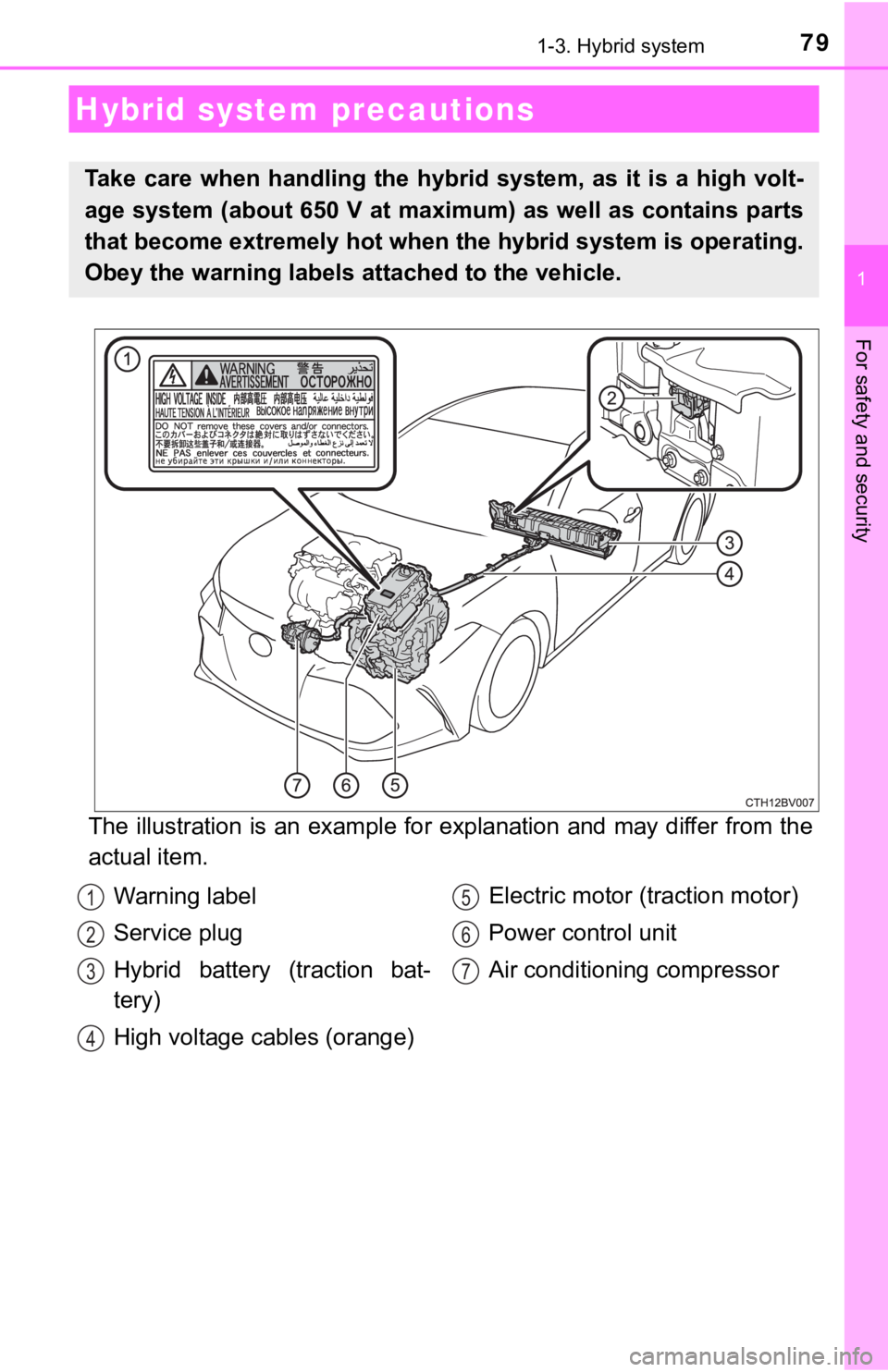
791-3. Hybrid system
1
For safety and security
The illustration is an example for explanation and may differ from the
actual item.
Hybrid system precautions
Take care when handling the hybrid system, as it is a high volt-
age system (about 650 V at maximum) as well as contains parts
that become extremely hot when the hybrid system is operating.
Obey the warning labels attached to the vehicle.
Warning label
Service plug
Hybrid battery (traction bat-
tery)
High voltage cables (orange)Electric motor (traction motor)
Power control unit
Air conditioning compressor1
2
3
4
5
6
7
Page 241 of 560
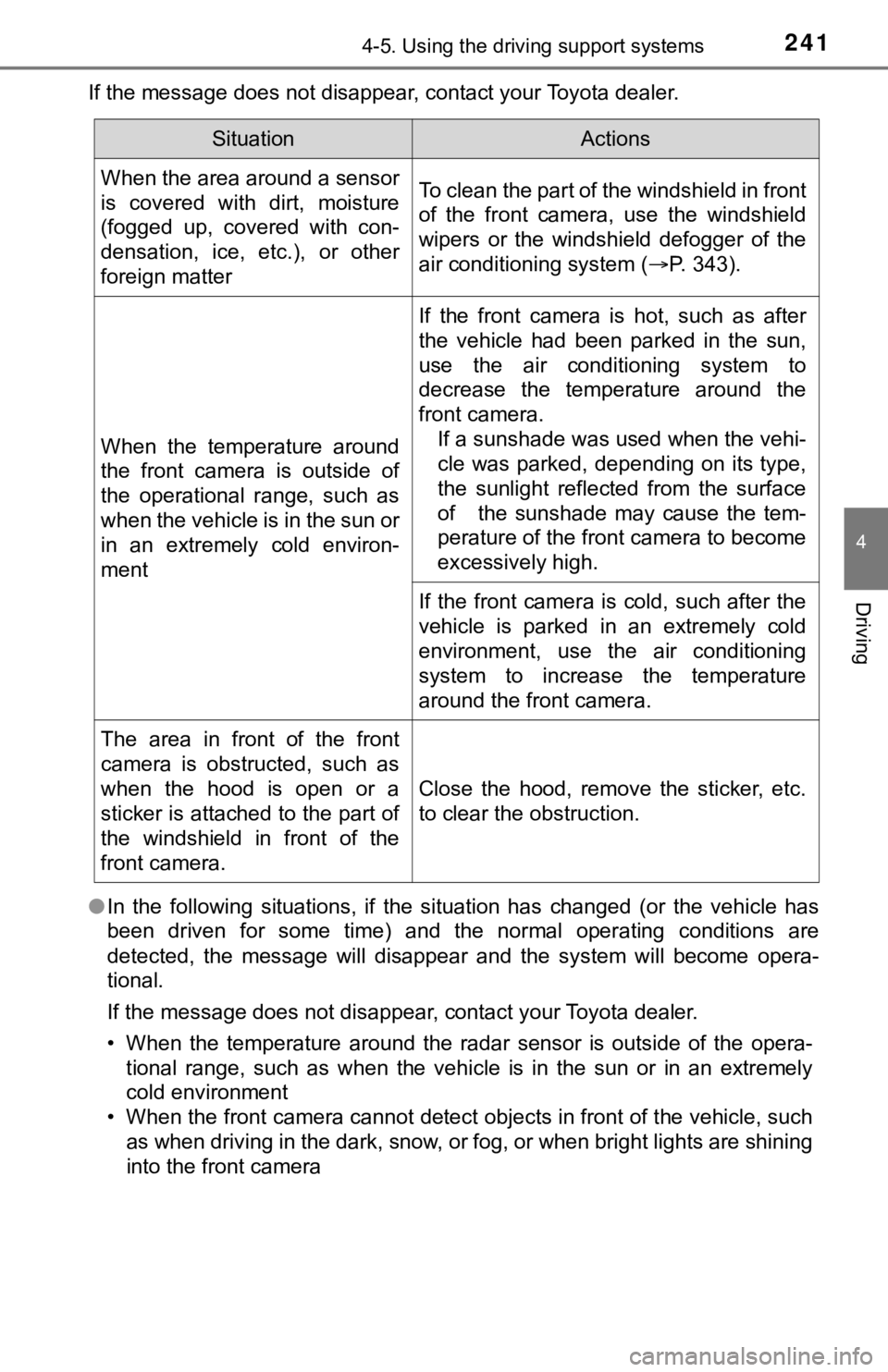
2414-5. Using the driving support systems
4
Driving
If the message does not disappear, contact your Toyota dealer.
●In the following situations, if the situation has changed (or the vehicle has
been driven for some time) and the normal operating conditions are
detected, the message will disappear and the system will become opera-
tional.
If the message does not disappear, contact your Toyota dealer.
• When the temperature around the radar sensor is outside of the opera-
tional range, such as when the vehicle is in the sun or in an extremely
cold environment
• When the front camera cannot detect objects in front of the vehicle, such
as when driving in the dark, snow, or fog, or when bright lights are shining
into the front camera
SituationActions
When the area around a sensor
is covered with dirt, moisture
(fogged up, covered with con-
densation, ice, etc.), or other
foreign matterTo clean the part of the windshield in front
of the front camera, use the windshield
wipers or the windshield defogger of the
air conditioning system (P. 343).
When the temperature around
the front camera is outside of
the operational range, such as
when the vehicle is in the sun or
in an extremely cold environ-
ment
If the front camera is hot, such as after
the vehicle had been parked in the sun,
use the air conditioning system to
decrease the temperature around the
front camera.
If a sunshade was used when the vehi-
cle was parked, depending on its type,
the sunlight reflected from the surface
of the sunshade may cause the tem-
perature of the front camera to become
excessively high.
If the front camera is cold, such after the
vehicle is parked in an extremely cold
environment, use the air conditioning
system to increase the temperature
around the front camera.
The area in front of the front
camera is obstructed, such as
when the hood is open or a
sticker is attached to the part of
the windshield in front of the
front camera.
Close the hood, remove the sticker, etc.
to clear the obstruction.
Page 287 of 560
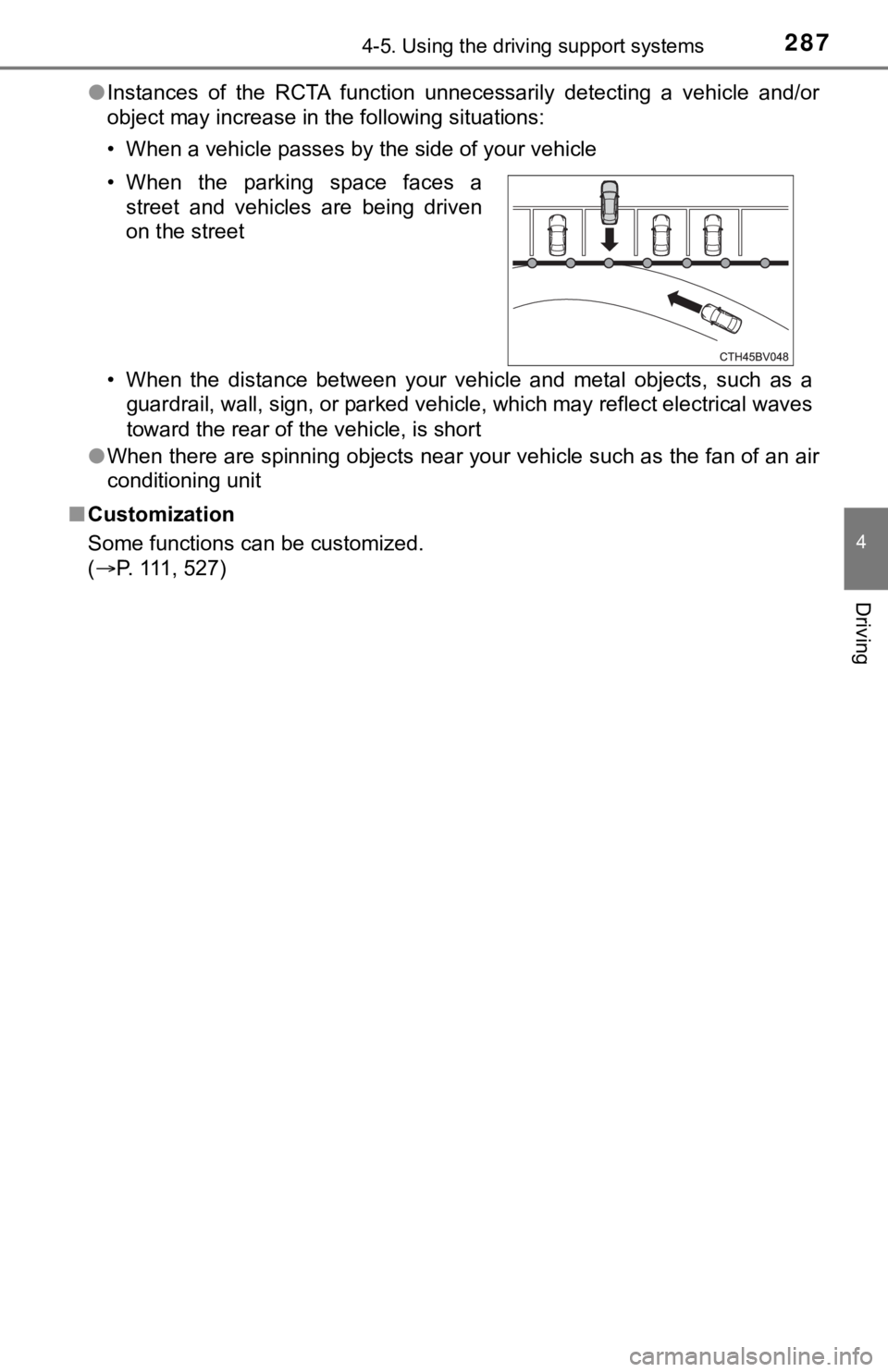
2874-5. Using the driving support systems
4
Driving
●Instances of the RCTA function unnecessarily detecting a vehicle and/or
object may increase in the following situations:
• When a vehicle passes by the side of your vehicle
• When the distance between your vehicle and metal objects, such as a
guardrail, wall, sign, or parked vehicle, which may reflect electrical waves
toward the rear of the vehicle, is short
●When there are spinning objects near your vehicle such as the fan of an air
conditioning unit
■Customization
Some functions can be customized.
(P. 111, 527) • When the parking space faces a
street and vehicles are being driven
on the street
Page 291 of 560

2914-5. Using the driving support systems
4
Driving
●In some situations, such as the following, the rear camera detection function
<00500044005c000300520053004800550044005700480003004800590048005100030057004b00520058004a004b00030057004b004800550048000300440055004800030051005200030053004800470048005600570055004c0044005100560003004c00
5100030057004b00480003004700480057004800460057004c[on area.
• When a three dimensional object, such as a pole, traffic cone, fence, or
parked vehicle, is detected
• When a moving object, such as a car or motorcycle is detected
• When backing up toward moving objects such as flags or puddles, or air-
borne matter, such as smoke, steam, rain, or snow
• When there is a pattern on the road, due to the road being made of cob-
blestone or gravel or having tram rails, traces of repair, white lines,
pedestrian crossings or fallen leaves on the surface
• When backing up on a metal cover (grating), such as those used for
drainage ditches
• When backing up toward the roadside or a bump in the road
• When an object is reflected in a puddle or on a wet road surface
• When there are shadows on the road
• When backing up over a bump in the road
• If the vehicle is significantly tilted, such as when carrying a heavy load
• When backing up toward an incline/decline
• If the suspension has been modified or tires of a size other than specified
are installed
• If the rear of the vehicle is raised or lowered due to the carried load
• If an electronic component, such as a backlit license plate or rear fog
light, is installed near the rear camera
• If a bumper protector, such as an additional trim strip, is installed to the
rear bumper
• If the orientation of the rear camera has been changed due to a collision
or other impact, or removal and installation
• If a towing eyelet is installed to the rear of the vehicle
• When the rear camera is obscured (dirt, snow, ice, etc. are attached) or
scratched
• When water is flowing over the rear camera lens
• If there is a flashing light in the detection area, such as the emergency
flashers of another vehicle
■Situations in which the rear camera detection function may be difficult to
notice
●If buzzer may be difficult to hear if the surrounding area is noisy, the volume
of the audio system volume is high, the air conditioning system is being
used, etc.
●If the temperature in the cabin is extremely high or low, the audio system
screen may not operate correctly.
Page 296 of 560

2964-5. Using the driving support systems
■The intuitive parking assist can be operated when
●Front corner sensors:
• The power switch is in ON mode.
• The shift lever is in other than P.
• The vehicle speed is less than about 6 mph (10 km/h).
●Front center sensors:
• The power switch is in ON mode.
• The shift lever is in other than P or R.
• The vehicle speed is less than about 6 mph (10 km/h).
●Rear corner and rear center sensors:
• The power switch is in ON mode.
• The shift lever is in R.
• The vehicle speed is less than about 6 mph (10 km/h).
■Intuitive parking assist display
When an object is detected while the Toyota parking assist monitor or pan-
oramic view monitor is in use, the warning indicator will appear in the upper
part of the screen even if the display setting has been set to off.
■Sensor detection information
●The sensor’s detection areas are limited to the areas around the vehicle’s
bumper.
●Depending on the shape of the object and other factors, the detection dis-
tance may shorten, or detection may be impossible.
●Objects may not be detected if they are too close to the sensor.
●There will be a short delay between object detection and display. Even at
slow speeds, there is a possibility that the object will come within the sen-
<00560052005500b600560003004700480057004800460057004c00520051000300440055004800440056000300450048004900520055004800030057004b004800030047004c00560053004f0044005c0003004c005600030056004b0052005a0051000300
440051004700030057004b0048000300450058005d005d0048[r sounds.
●Thin posts or objects lower than the sensor may not be detected when
approached, even if they have been detected once.
●It might be difficult to hear beeps due to the volume of audio system or air
flow noise of the air conditioning system.
■If a battery terminal has been disconnected and reconnected
The system needs to be initialized.
To initialize the system, drive the vehicle straight ahead for 5 seconds or more
at a speed of approximately 22 mph (35 km/h) or more.
■If “Parking Assist Unavailable Please Clean Parking Assist Sensor” is
displayed on the multi-information display
A sensor may be dirty or covered with snow or ice. In such cases, if it is
removed from the sensor, the system should return to normal.
Also, due to the sensor being frozen at low temperatures, a malfunction dis-
play may appear or an object may not be detected. If the sensor thaws out,
the system should return to normal.
Page 318 of 560
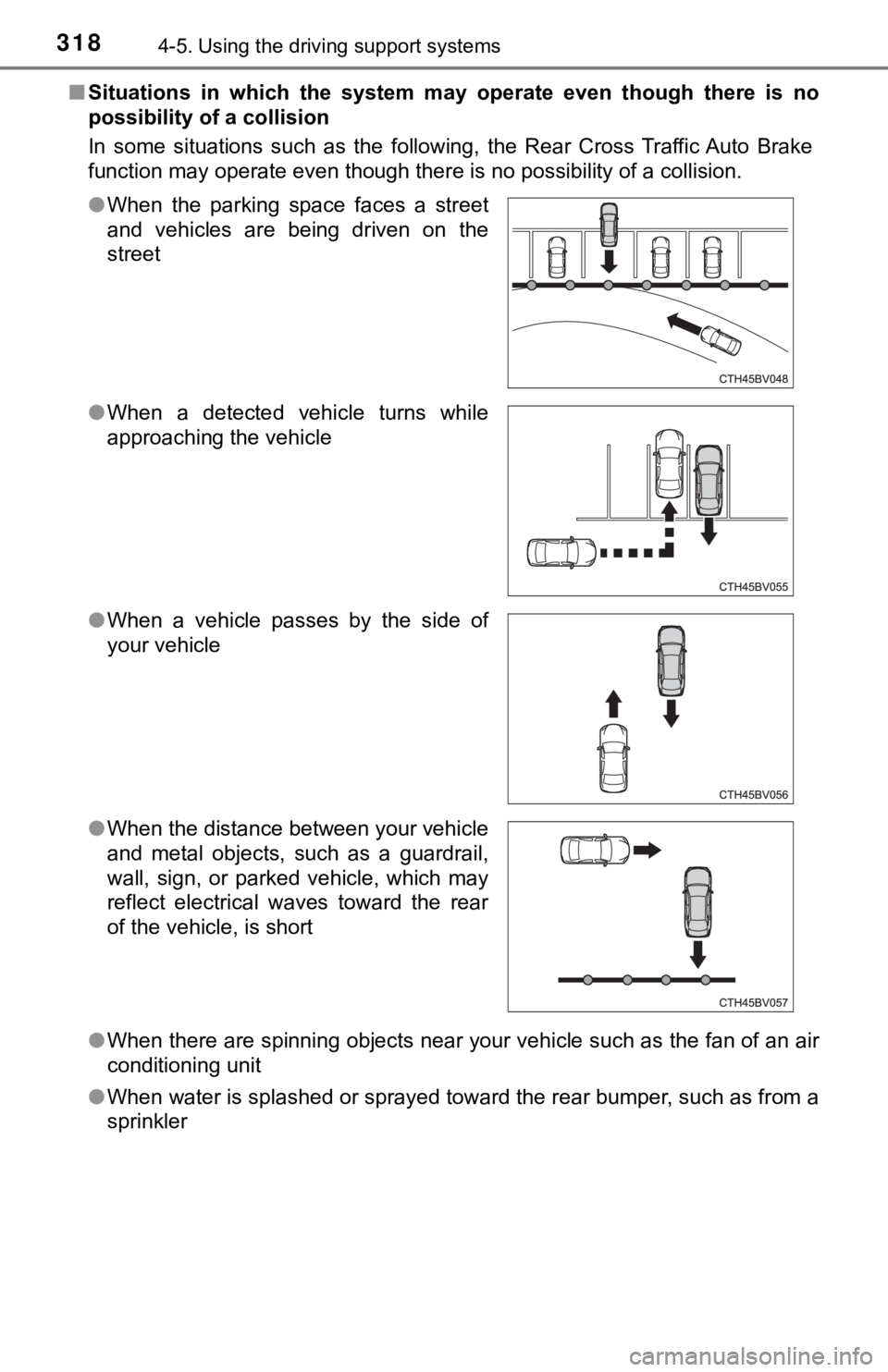
3184-5. Using the driving support systems
■Situations in which the system may operate even though there is no
possibility of a collision
In some situations such as the following, the Rear Cross Traffic Auto Brake
function may operate even though there is no possibility of a collision.
●When there are spinning objects near your vehicle such as the fan of an air
conditioning unit
●When water is splashed or sprayed toward the rear bumper, such as from a
sprinkler ●When the parking space faces a street
and vehicles are being driven on the
street
●When a detected vehicle turns while
approaching the vehicle
●When a vehicle passes by the side of
your vehicle
●When the distance between your vehicle
and metal objects, such as a guardrail,
wall, sign, or parked vehicle, which may
reflect electrical waves toward the rear
of the vehicle, is short
Page 322 of 560

3224-5. Using the driving support systems
■Operation of the air conditioning system in Eco drive mode
Eco drive mode controls the heating/cooling operations and fan speed of the
air conditioning system to enhance fuel efficiency (P. 338). To improve air
conditioning performance, adjust the fan speed or turn off Eco drive mode.
■Auto Glide Control
When Auto Glide Control operates, the AGC indicator light will illuminate.
●Auto Glide Control may not operate in the following situations:
• When the brake pedal is depressed
• When a shift position other than D is selected
• When the vehicle speed is approximately 10 mph (15 km/h) or lower
• When the vehicle is accelerating on a downward slope
• When the PCS (Pre-Collision System) is operating
• When the dynamic radar cruise control with full-speed range is operating
• When the Intelligent Clearance Sonar system is operating
• When the TRAC or VSC system is operating
• When the TRAC or VSC system is disabled by pressing the VSC OFF
switch
■Sport mode automatic deactivation
Sport mode is automatically deactivated if the power switch is turned off after
driving in sport mode. ●While driving in Eco drive mode with D
selected, releasing the accelerator
pedal will activate Auto Glide Control
under certain conditions. (Auto Glide
Control may activate before the acceler-
ator pedal is fully released.)
When Auto Glide Control operates, the
electric motor (traction motor) will be
controlled, reducing the deceleration
force and allowing the vehicle to coast,
enhancing fuel economy.
Page 330 of 560
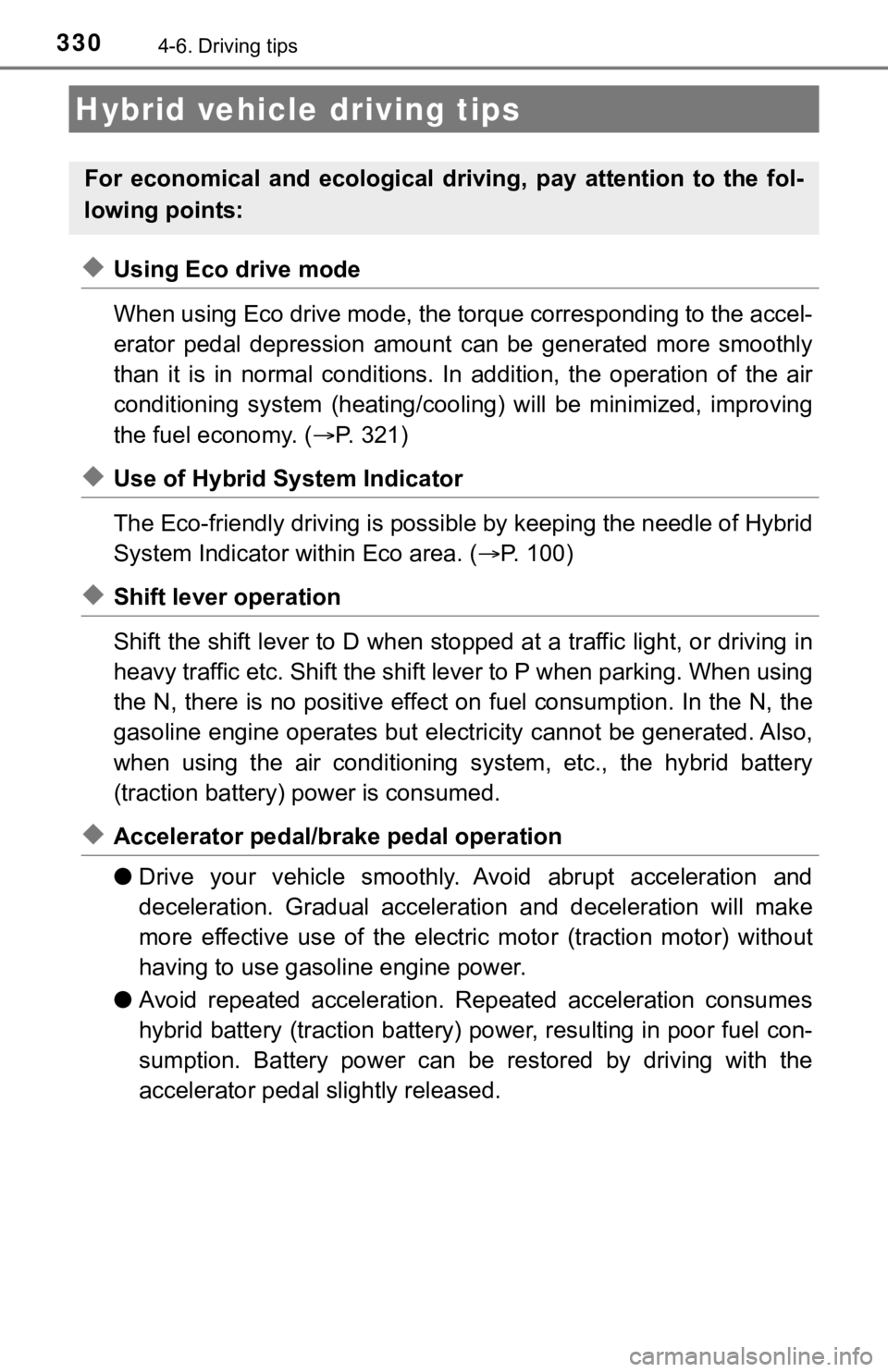
3304-6. Driving tips
◆Using Eco drive mode
When using Eco drive mode, the torque corresponding to the accel-
erator pedal depression amount can be generated more smoothly
than it is in normal conditions. In addition, the operation of the air
conditioning system (heating/cooling) will be minimized, improving
the fuel economy. (P. 321)
◆Use of Hybrid System Indicator
The Eco-friendly driving is possible by keeping the needle of Hybrid
System Indicator within Eco area. (P. 100)
◆Shift lever operation
Shift the shift lever to D when stopped at a traffic light, or driving in
heavy traffic etc. Shift the shift lever to P when parking. When using
the N, there is no positive effect on fuel consumption. In the N, the
gasoline engine operates but electricity cannot be generated. Also,
when using the air conditioning system, etc., the hybrid battery
(traction battery) power is consumed.
◆Accelerator pedal/brake pedal operation
●Drive your vehicle smoothly. Avoid abrupt acceleration and
deceleration. Gradual acceleration and deceleration will make
more effective use of the electric motor (traction motor) without
having to use gasoline engine power.
●Avoid repeated acceleration. Repeated acceleration consumes
hybrid battery (traction battery) power, resulting in poor fuel con-
sumption. Battery power can be restored by driving with the
accelerator pedal slightly released.
Hybrid vehicle driving tips
For economical and ecological driving, pay attention to the fol-
lowing points: